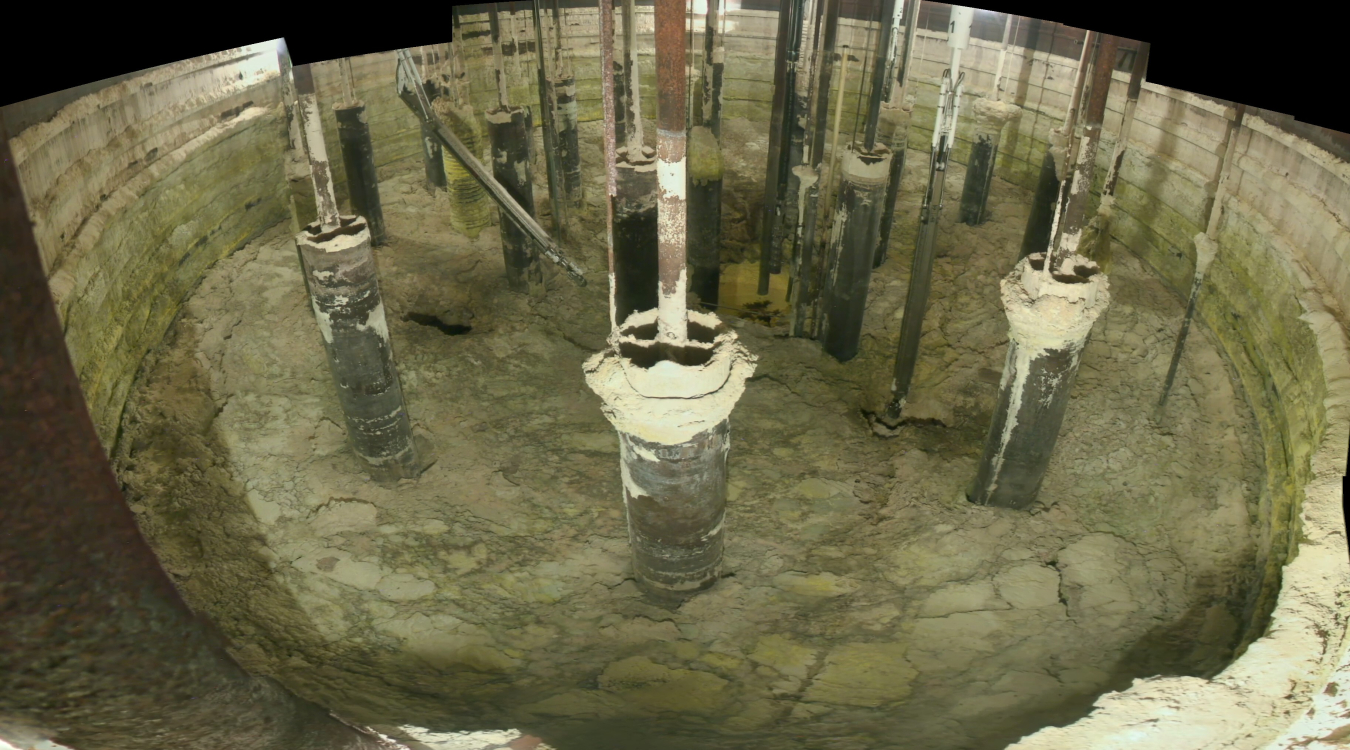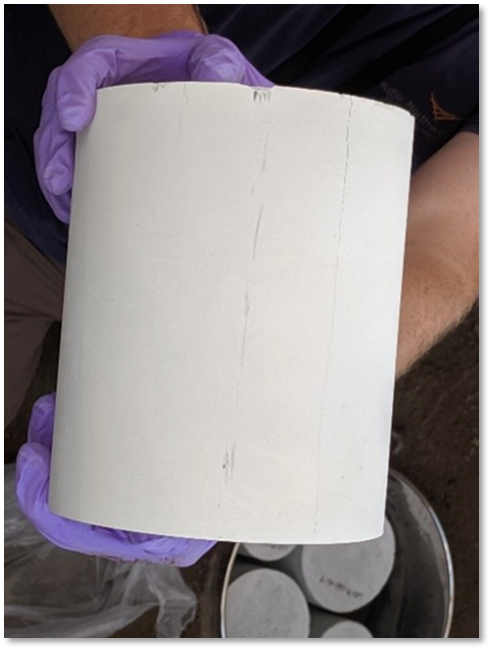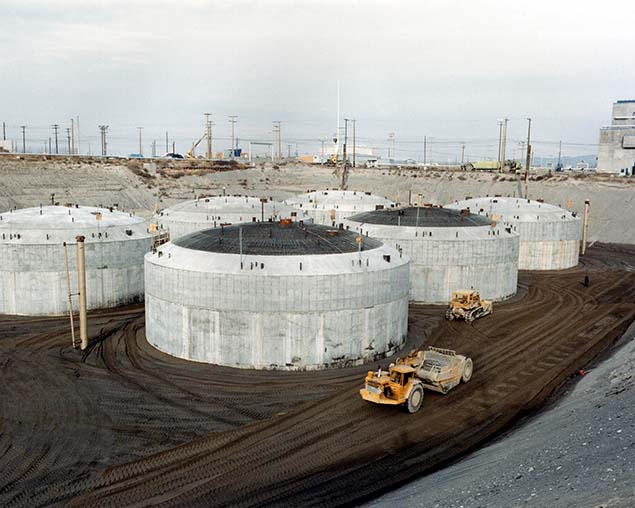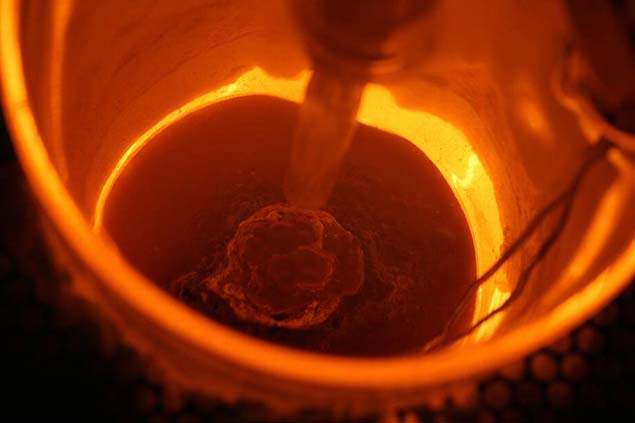High-level waste at Hanford
Cleaning up Hanford’s most dangerous and radioactive mixed waste
The Hanford Site, part of the Manhattan project, specialized in creating plutonium for the atomic bomb. Decades of plutonium production left 56 million gallons of highly radioactive and chemically hazardous waste in 177 huge underground tanks at the Hanford Site. Cleaning up and disposing of this waste is some of the most dangerous and complicated cleanup work left at Hanford. Tank waste cleanup is required for the health and safety of communities in the Pacific Northwest.
Ecology is working closely with the U.S. Department of Energy to ensure safe and effective retrieval, treatment, and permanent disposal of this tank waste to deliver on the mission at Hanford.
Six of the double-shell tanks under construction in 1975.
Defining high-level
The term “high level” is defined in federal law. You could think of it as the byproduct of a specific nuclear process. In technical terms, high-level waste includes the irradiated fuel from a nuclear reactor and the waste that is generated when that fuel is processed to extract other products.
Specifically, the federal Nuclear Waste Policy Act (42 U.S.C. 10101(12)) – defines high-level waste as:
- “(A) the highly radioactive material resulting from the reprocessing of spent nuclear fuel, including liquid waste produced directly in reprocessing and any solid material derived from such liquid waste that contains fission products in sufficient concentrations,”
- And “(B) Other highly radioactive material that the [Nuclear Regulatory] Commission, consistent with existing law, determines by rule requires permanent isolation.”
Federal laws further require high-level nuclear waste to be treated to make it safe for disposal in a deep geologic repository, in other words, somewhere secure and enclosed that would prevent the waste from harming people or the environment.
High-level at Hanford
More than 100,000 tons of uranium were processed at Hanford to make about 75 tons of plutonium, accounting for two-thirds of the nation’s plutonium stockpile.
Hanford’s nine nuclear reactors first had to irradiate this uranium fuel—that is expose it to radiation to create plutonium. The site’s massive processing facilities then used a succession of toxic chemical baths to extract small amounts of plutonium produced during irradiation.
This was a complex process that left behind millions of gallons of “mixed waste” that is both highly radioactive and also chemically hazardous created during production. This mixed waste went into Hanford’s 177 underground tanks. Every gallon of waste in the tanks is currently managed as high-level.

AX-101 before retrieval in 2023
Cleaning up tank waste
The 56 million gallons of tank waste are defined and managed as high-level waste. However, an approach was needed to appropriately reduce the volume of high-level waste needing deep geologic disposal.
To that end, in the 1990s, Ecology, the federal Nuclear Regulatory Commission, and Energy agreed 90 percent of Hanford’s tank waste could be treated as low-level – referred to at Hanford as low-activity. However, this waste had to be pretreated to reduce its radioactivity by removing key radionuclides (for example by using the Tank-Side Cesium Removal System). Low-activity waste is then immobilized and can be disposed of in near-surface landfill rather than a deep geologic repository.
Waste being melted into glass.
Both low-activity waste and high-level waste were to be incorporated into a solid glass form. This process is called vitrification. Once vitrified, the toxic chemicals and radioactive waste will remain stable in the glass for thousands of years, and can be safely disposed. Vitrified low-activity waste can be disposed of permanently in the permitted Integrated Disposal Facility at Hanford (an engineered landfill), while vitrified high-level waste must go to a deep geologic repository.
Energy currently uses an existing regulatory process to reclassify high-level waste. The process, called a “Waste Incidental to Reprocessing Determination (WIR)” is managed by Energy with reviews from the Nuclear Regulatory Commission. This determination would allow pretreated waste to be vitrified and appropriately reclassified as low-activity. WIR is the process used to reclassify about 90 percent of Hanford’s tank waste.
Alternative treatments
Ecology has remained open to alternative ways of treating Hanford low-activity tank waste other than vitrification. However, we have always insisted that any treatment for disposal at Hanford be at least as good and effective as vitrified glass given Hanford’s geology, depth to groundwater, and proximity to the Columbia River. So far, no alternatives have met this mark.
One such alternative, called “grouting,” entails encapsulating low-activity tank waste in a concrete-like mixture. This form of waste is porous and – relative to radioactive contaminants – short lived.
We’re opposed to using grouting as an alternative treatment for low-activity waste being disposed of at Hanford, because several studies have shown there would be an unacceptable impact to groundwater if disposed of onsite. One such study was the Tank Closure Waste Management Environmental Impact Statement.

A solidified grout sample.
(Photo courtesy, U.S. Department of Energy)
Hanford’s geology is not suitable for grouted tank waste, which is more porous in nature and may leak over time. The area is made up of a lot of sand and gravel, which liquids can move quickly through to groundwater below. This leaves Hanford as a non-suitable site for this type of waste.
However, we do support offsite disposal of grouted low-activity tank waste at facilities that do have more robust geology and that don’t have the groundwater contamination and proximity to surface water concerns we have here at Hanford.
Under the ”Holistic Agreement” recently finalized in 2025 by the Tri-Party Agreement agencies, low-activity waste will be retrieved from 22 tanks, pretreated at Hanford, grouted either on Hanford or off the Hanford Site, and permanently disposed of offsite. This pretreated waste will be reclassified through the existing regulatory WIR process described above.
Reinterpreting high-level waste
In 2018, Energy adopted a new interpretation of high-level waste, basing the definition on the level of radioactivity in the waste, rather than how the waste was generated.
This new interpretation gives Energy unilateral authority to determine what constitutes high-level nuclear waste, and allows Energy to bypass existing regulatory pathways for appropriately reclassifying waste.
Under the Holistic Agreement, Energy agreed to refrain from applying its high-level waste interpretation when disposing of treated waste or closing tanks systems at Hanford.
This element of the Holistic Agreement is important because, if the new interpretation is applied at Hanford, it could allow Energy to leave millions more gallons of waste currently designated as high-level in tank systems and fill them with grout rather than retrieving the waste for treatment and permanent disposal.
Large amounts of waste left in tanks, even if the waste is grouted in the tank, presents risk of waste leaking out of the tanks into the soil, groundwater, and Columbia River, according to the Tank Closure Waste Management Environmental Impact Statement. This kind of contamination could last for thousands of years and is not an acceptable outcome to the state.
Ecology is opposed to Energy using this interpretation to unilaterally change the designation of high-level waste and reclassify it. This high-level waste needs to be disposed of in a deep geologic repository, not onsite.
Contact information
Ryan Miller
Communications Manager
Ryan.Miller@ecy.wa.gov
509-537-2228



